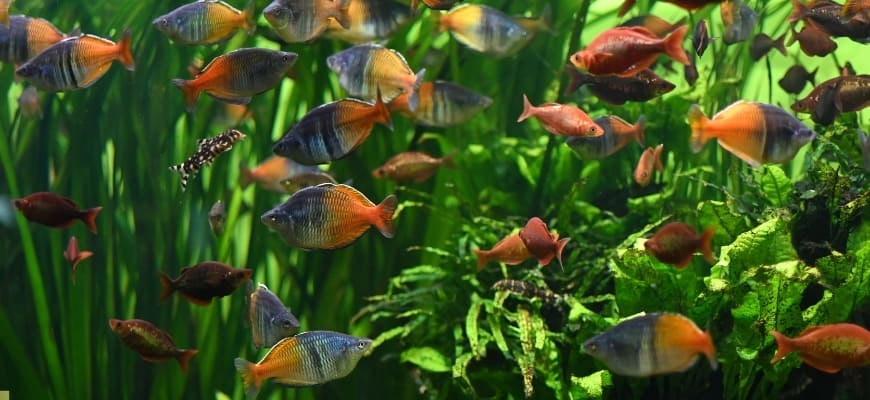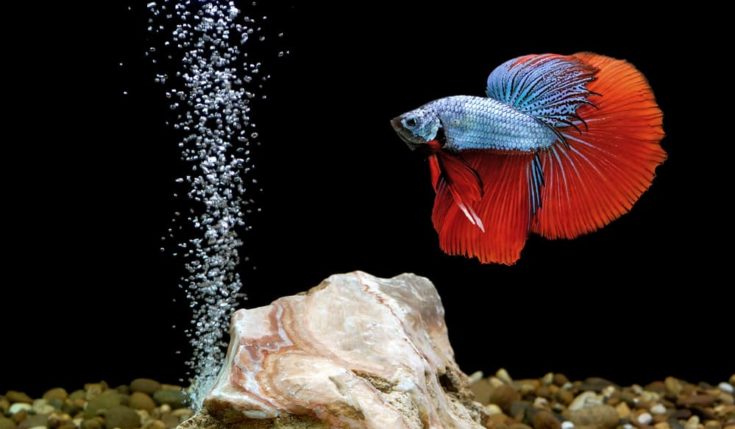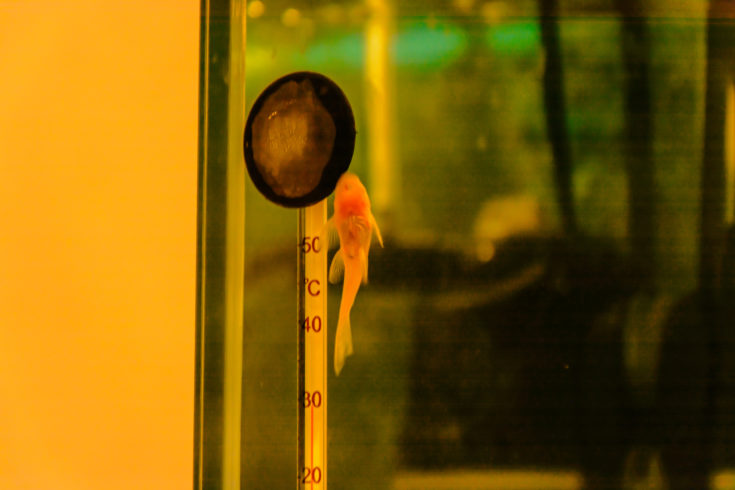Picture the scene. You go to your beloved betta’s tank to feed him one morning. But, oh no! Your beautiful betta has nasty white patches on his scales and isn’t interested in his breakfast! What could be the problem?
Sounds like your betta fish has Columnaris. So, what is Columnaris, and what causes it?
In the fight against fish diseases, knowledge is power! So read this guide now to find out everything you need to know about Columnaris betta, including how to diagnose, treat, and prevent this potentially fatal condition.
What Is Columnaris Betta Disease?
Columnaris is a very common bacterial infection that affects freshwater fish, including those in your aquarium and wild fish, such as trout and salmon. Interestingly, this species of bacteria doesn’t affect saltwater fish species.
You might also hear the disease referred to by other names, including:
- Cotton wool disease
- Saddleback disease
- Guppy disease
- Cottonmouth disease
It’s the Flavobacterium columnare bacteria that causes Columnaris. These are tiny bacteria that can only be viewed under a microscope. The bacteria are rod or column-shaped, hence their name. Columnaris is a bad boy bacteria that is well capable of killing any species of freshwater fish, including bettas, if you don’t treat your pet quickly.
Columnaris is very dangerous and will kill your fish alarmingly quickly if it’s left untreated. The disease is highly contagious, too. So, if one of your betta’s tank mates contracts Columnaris, it’s likely that your betta buddy will contract it, too.
How Columnaris Betta Disease Spreads
Like many species of bacteria, including the Ichthyophthirius multifiliis parasite that causes White Spot disease, Columnaris is often already present in your aquarium. So, what causes outbreaks of the disease?
There are certain conditions in your tank that can trigger an outbreak of Columnaris, including:
- Bioloads that exceed the capacity of your filtration system
- Overcrowding
- Insufficient levels of dissolved oxygen in the water column
Heavy Bioload
If your tank is dirty and the filter is not efficient, the nitrate levels in the water will increase. That’s often the case in small betta tanks and is the reason why you must always use a filter for your fish tank, no matter how large or small it might be.
You must also be sure to carry out partial water changes of around 20% every week and keep the filter media properly maintained.
Don’t cram too many fish into the tank! The more fish you have, the more food they need, and the more waste they produce. All of that adds considerably to the load on your filter, potentially leading to increased nitrate levels and potential ammonia spikes.
Stress

In many home tanks, overcrowding is a big problem. Bettas are fiercely territorial and if kept in a tank with too many tank mates and not enough hiding places, they can become highly stressed. When your fish is stressed out, his immune system is weakened, leaving the betta open to attack by parasites, such as Columnaris.
The poor water conditions mentioned above are a major cause of stress in aquarium fish, too.
Lack Of Dissolved Oxygen
Fish need oxygen to survive. All fish species derive most of their oxygen requirements from the dissolved oxygen in the tank water. However, there are some fish that are also able to breathe air via their labyrinth organ. There are many species of Anabantoids or labyrinth fishes, and your betta buddy is one of them.
Your betta actually needs to breathe air since his oxygen requirements are not met solely through what the fish can extract from the water column. That’s why you’ll see your betta buddy darting to the surface periodically to grab a gulp of air.

If the tank is overcrowded or has a very small surface area, it’s likely that the levels of oxygen in the water will be low. You can overcome that to some extent by using an air stone or bubbler, adding plenty of live plants to the tank, or choosing a filtration system that causes surface agitation.
Can Columnaris Infect An Already Sick Betta Fish?
Yes, absolutely.
If your betta is already sick with another bacterial infection, Columnaris bacteria can enter the fish’s body and cause even more problems. Also, areas on the fish’s skin that have been affected by previous diseases can provide an entry point for Columnaris betta.
How Do Columnaris Symptoms Affect Your Betta Fish?
As I mentioned above, Columnaris is potentially fatal to your betta. But what do the bacteria actually do to affect your betta?
The disease destroys the tissue in certain parts of the fish’s body, causing the skin to slough off, which appears as cloudy patches on the betta’s body. Excessive mucus can also form around the betta’s head and gills. The areas that are most commonly affected by Columnaris include:
- Gills
- Fins
- Skin of the body and head
The usual starting place for infection is on the fish’s tail, causing it to become ragged and frayed. The damage often then extends to the betta’s fins. Simultaneously, mucus begins to accumulate on the fish’s gills so that they become discolored. As the infection progresses, the betta’s gills are damaged, and the fish will struggle to breathe.
You may see cloudy or white ulcers appearing on the fish’s body. In advanced cases, skin loss often occurs.
How Does That Affect Your Betta Fish?
So how does all that affect your fish?
- When the betta’s fins are damaged, he will find it very difficult to swim on an even keel, often tipping over onto one side or even swimming upside down.
- If mucus accumulates and the gills become damaged, your betta buddy will struggle to breathe. He will appear as though he’s gasping for breath and may breathe more rapidly than usual. The gills may flare and appear red and inflamed.
The fish might also spend more time than usual at the water surface, attempting to breathe.
- Ulcers or wounds on the skin enable the white fungus to grow, and the epidermal material gradually sloughs away. That allows other bacteria to attack your pet.
Is Columnaris Betta Disease Fatal?
The bad news for fish owners is that Columnaris disease is often fatal if you don’t identify and treat it immediately and correctly.
Old, sick, and stressed fish are more likely to die from Columnaris disease and often succumb within a few days. Even if you do treat the disease, it can be fatal, especially if you didn’t spot the problem and deal with it before too much damage was done to the fish.
To make matters worse, there are two strains of Columnaris. One strain is incredibly fast-acting, often killing the fish within 24 hours. Many times, you’ll find your fish dead in his tank before you even realize there’s anything wrong.
The second strain is slower to act, but you still only have a couple of days to act before it’s too late to save your pet.
Other Symptoms Of Columnaris In Bettas
Columnaris can be confused with other conditions such as fungus, so it’s important to know what to look out for. As well as the symptoms mentioned above, there are other signs to watch out for, including:
- Bleached, off-color patches on the fish’s body.
- Flat patches of white, yellow, or orange, depending on your pet’s natural body color, appear on the fish’s body.
- White scales that flake off the fish, leaving exposed skin beneath.
- In some cases, a small round patch that looks like a saddle appears behind the fish’s dorsal fin, giving the disease the common name of Saddleback disease.
- Sometimes, the skin around the fish’s mouth is affected, turning white and flaky so that the betta looks as though he’s wearing lipstick.
- Poor appetite and inactivity are also symptoms of Columnaris.
Your betta might flash and rub against things in the tank. However, that behavior can be symptomatic of other diseases, such as Ich.
What Causes Columnaris?
Columnaris is present in many aquariums but, as already mentioned above, is usually triggered by any or all of the following:
An Overstocked Tank
Putting too many fish into your tank is a major cause of stress in aquarium fish, as it can cause poor water conditions, territorial disputes, and competition for food.
Harassment From Other Fish
Bettas are highly territorial creatures that will get stressed if they find themselves being bullied or harassed by other fish.
That said, many betta fish do enjoy company in their tank, but be sure to choose your betta’s tank mates carefully.
Inconsistent Temperatures/pH Levels In The Water
Betta fish are quite sensitive to water temperature and pH levels. If the temperature is too warm or too cool, the fish will become stressed. Likewise, if the pH level is out of whack with what the fish can tolerate, he will get stressed and probably become sick.
Ideal water parameters for betta fish are:
- Temperature: 75°- 81°F
- pH range: 6.5 to 7.5
- GH: 3-4 dGH
- KH: 3-5 dKH
Check the water parameters and temperature regularly as a part of your weekly tank maintenance routine.
Poor Water Quality In General
Dirty water and high levels of ammonia, nitrites, and nitrates are all potentially dangerous for your fish.
Ammonia and nitrite levels should be zero, and nitrates should be around 20ppm, ideally less if possible.
Brought From Another Tank
Columnaris and other bacteria can be introduced to a clean tank, usually carried in on plants or fish.

Always quarantine any new livestock and plants for at least 14 days before you introduce them to your display tank.
How To Treat Columnaris In Betta Fish
Now you know how to spot Columnaris in Bettas, you want to know how to treat it.
Although using the following treatment gives your fish a good shot at beating the disease, you should remember that Columnaris is a very dangerous disease that is often fatal. For that reason, you don’t want to try treating the tank with aquarium salt or DIY home remedies, as those will not be effective against this nasty bacteria.
Quarantine
Start by putting any fish that show symptoms of Columnaris into a separate quarantine tank. That keeps your other fish protected from catching the disease.
Also, sick fish can be bullied by their healthy tank mates, and bullying only adds to the stress your sick fish is already feeling. From a financial perspective, if you use a small hospital tank, you won’t need as much medication, potentially making you substantial savings.
Finally, dosing your main tank can stress healthy fish and kill off the healthy bacteria in your filter media.
Check Your Water Quality
If your water quality is poor, you’re opening the door to many common fish diseases. So, if you’re not doing so alreadyThe following course, test your water every week to make sure that the parameters are suitable for your betta fish, as outlined above.
Most fish medications work better in a clean tank, giving your pet the best chance of recovery.
Turn Down The Heat
Unlike Ich, Columnaris can spread more quickly if the water is warm. So, ideally, you want to keep the tank temperature below 75˚F.

When reducing the temperature in the tank, make sure that you do it slowly. All fish are very sensitive to temperature changes, and they can suffer from temperature shock if you lower it too fast. So, I recommend that you decrease the water temperature by 2˚F every hour or so until you get the temperature that you want. Use an accurate thermometer to check the water temperature as you go.
Before lowering the water temperature, check the tolerance of all the fish in your collection and aim for the lowest temperature that’s acceptable to them all.
Dose With Columnaris Medication
Before you add any medication to your aquarium, remove the chemical filtration media, or it will remove certain drugs from the water, rendering your treatment ineffective.
Experts recommend using a combo of kanamycin and nitrofurazone to treat Columnaris. The brand of the products that you choose is not important, as long as one contains kanamycin and the other contains nitrofurazone. We recommend that you use Furan 2 and Kanaplex, as many hobbyists report success when using these medications.
The following course of treatment is effective:
- Day 1 – Use both medications, as directed by the manufacturer
- Day 2 – Nitrofurazone
- Day 3 – 25% water change, use both medications
- Day 4 – Nitrofurazone
- Day 5 – 25% water change, use both medications
If your fish is very severely affected by Columnaris, you’ll probably need to do back-to-back treatments over a total of ten days.
How To Prevent Columnaris In Your Betta Fish Tank
Since Columnaris generally attacks fish that are weak or stressed, you can keep your aquarium safe for your betta and other fish by making the tank a stress-free zone. You can do that by:
- Cycling your fish tank
- Quarantining new fish and plants before adding them to your display tank
- Not overstocking the aquarium
- Only stocking compatible fish and invert species
- Regularly testing your water quality
- Maintaining stable water parameters
- Keeping the tank clean and well-maintained
- Performing regular water changes
- Not overfeeding your betta fish and feeding a correct, balanced diet
If necessary, reduce the general hardness (GH) of the water in your tank. Hard water makes it easier for the Columnaris bacteria to attach themselves to your fish.
Columnaris Betta FAQ
Here are some of the most commonly asked questions about Columnaris and its treatment:
Q: Is Columnaris transferable to humans?
A: No. Luckily for us fishkeepers, Columnaris cannot jump species and affect humans. However, it is highly contagious among communities of fish that are already weakened by stress.
Q: Can Columnaris go away without treatment?
A: Unfortunately, this is a disease that won’t magically vanish if you don’t treat it. Depending on which strain of Columnaris bacteria your fish contract, it can prove fatal within 24 to 72 hours.
Q: How long can a fish live when infected with Columnaris?
A: Columnaris disease is usually fatal within just a few days, maybe even just one day if you don’t identify and treat the disease immediately.
Q: How long can Columnaris bacteria survive without a host fish?
A: Flavobacterium columnare are able to survive for over 30 days without a host fish to latch onto. So, that means the bacteria could live in your aquarium for a month after you’ve added freshwater. Treated water and older water won’t contain the bacteria.
It’s thought that Columnaris can live in water without a host for a maximum of 35 days.
Q: Why does my betta look fuzzy?
A: If your fish develops a fuzzy appearance on his skin, it’s almost certainly a bacterial infection that could be Columnaris. To be on the safe side, treat your betta buddy for Columnaris, as outlined above. But watch out for other symptoms, too, such as white spots that could indicate an Ich infection.
In Conclusion
Did you find this guide to Columnaris helpful? If you did, please share it with other fishkeeping enthusiasts.
Columnaris is a serious bacterial infection that can be fatal to your betta fish. Although it’s possible to treat this disease, it’s far better to prevent it by keeping your tank clean and well-maintained, quarantining new fish, and avoiding overcrowding and other situations that could stress your fish.
If you have any questions about Columnaris or any other fish diseases that could affect your betta, ask us in the comments box below.